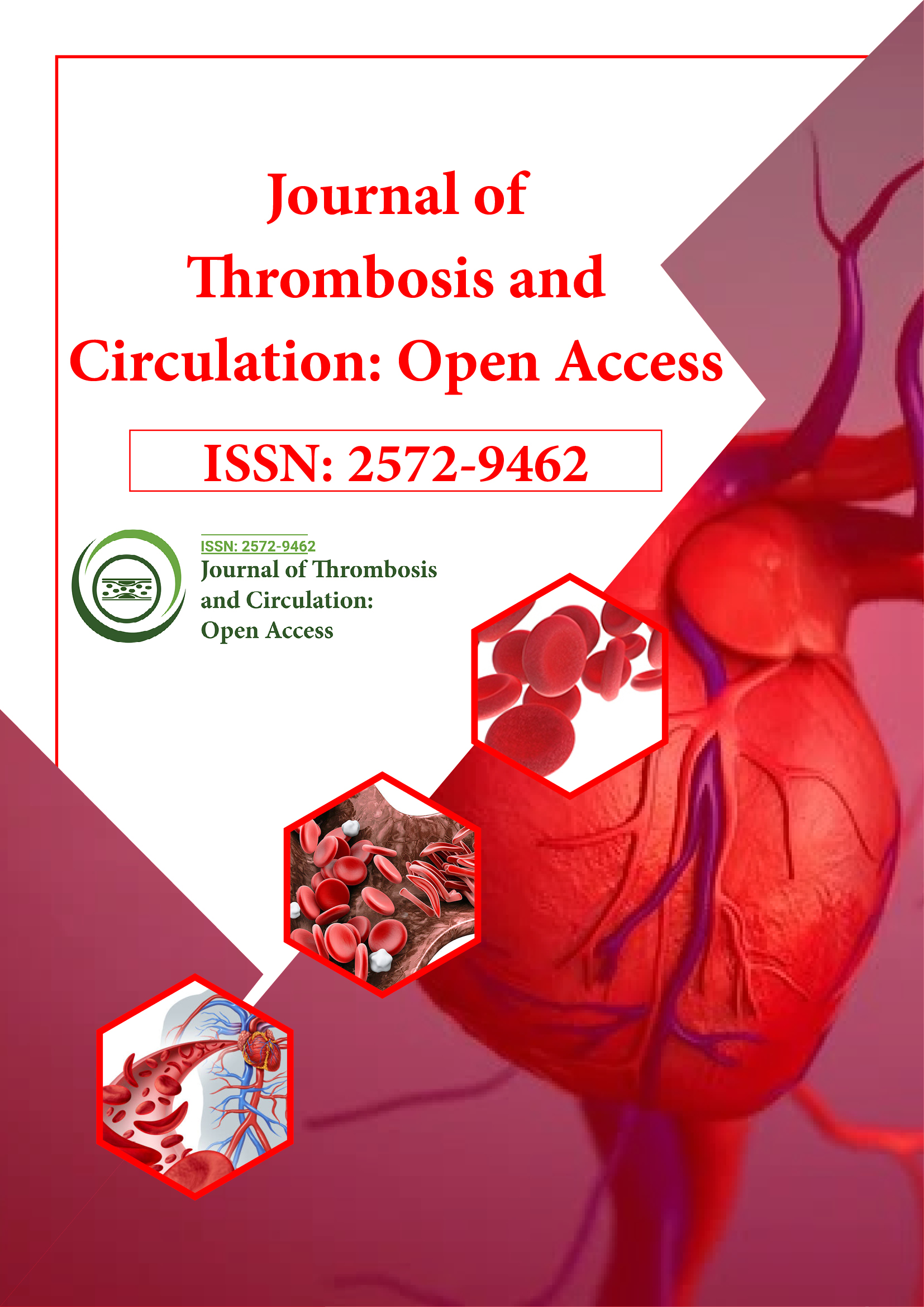Indexed In
- RefSeek
- Hamdard University
- EBSCO A-Z
- Publons
- Google Scholar
Useful Links
Share This Page
Journal Flyer

Open Access Journals
- Agri and Aquaculture
- Biochemistry
- Bioinformatics & Systems Biology
- Business & Management
- Chemistry
- Clinical Sciences
- Engineering
- Food & Nutrition
- General Science
- Genetics & Molecular Biology
- Immunology & Microbiology
- Medical Sciences
- Neuroscience & Psychology
- Nursing & Health Care
- Pharmaceutical Sciences
Opinion Article - (2025) Volume 11, Issue 2
Genetic Polymorphisms and Their Influence on Thrombotic Risk in the General Population
Marcus Albrecht*Received: 30-May-2025, Manuscript No. JTCOA-25-29337 ; Editor assigned: 02-Jun-2025, Pre QC No. JTCOA-25-29337 (PQ); Reviewed: 16-Jun-2025, QC No. JTCOA-25-29337 ; Revised: 23-Jun-2025, Manuscript No. JTCOA-25-29337 (R); Published: 30-Jun-2025, DOI: 10.35248/2572-9462.25.11.303
Description
Thrombosis is a multifactorial disorder influenced by environmental, lifestyle and genetic factors. While acquired risk factors such as immobilization, surgery, malignancy, and hormonal therapy have been well-documented, increasing attention is being given to the role of genetic polymorphisms in predisposing individuals to thrombotic events. Advances in molecular diagnostics and genome-wide association studies have uncovered a spectrum of genetic variants associated with increased thrombosis risk, particularly in Venous Thromboembolism (VTE). Understanding these inherited predispositions is essential for improving risk stratification and developing personalized therapeutic approaches.
Among the most recognized genetic factors is the Factor V Leiden mutation, a single nucleotide polymorphism that results in resistance to activated protein C. Heterozygous carriers have a three- to eight-fold increased risk of VTE, while homozygous individuals face an even higher thrombotic tendency. This mutation is prevalent in European populations but rare in Asian and African ancestries. Another common genetic variant is the prothrombin G20210A mutation, which results in elevated prothrombin levels and subsequently a hypercoagulable state. This variant similarly confers a significantly increased risk for first-time and recurrent VTE.
Deficiencies in natural anticoagulants protein C, protein S and antithrombin have long been known to increase thrombotic risk. These conditions are typically inherited in an autosomal dominant fashion and present early in life, often with unprovoked or recurrent thrombotic episodes. Genetic testing for these deficiencies is crucial in young individuals with thrombosis or those with a positive family history. However, interpretation of laboratory assays must be conducted carefully, as acute thrombosis or anticoagulation can interfere with accurate measurement.
More recently, polymorphisms in genes related to fibrinolysis, such as PAI-1 and tPA, and platelet activation, such as GP IIb/IIIa, have been studied for their potential contributions to thrombosis. While their individual impact may be modest, they may exert cumulative effects when occurring in combination or in the presence of environmental triggers. In this context, polygenic risk scores are emerging as promising tools to integrate multiple genetic variants and provide a quantitative measure of thrombotic susceptibility.
The clinical utility of genetic screening in thrombosis remains a topic of debate. Current guidelines recommend selective testing based on personal or family history, age of onset and the presence of provoking factors. Routine testing in the general population is not advised due to concerns about cost-effectiveness, psychological impact and potential for misinterpretation. Nonetheless, genetic insights can guide decisions in high-stakes scenarios such as anticoagulation management in pregnancy, perioperative risk assessment and thromboprophylaxis during long-haul travel or hormonal therapy.
Of particular interest is the intersection of genetics and acquired risk factors. For instance, individuals with Factor V Leiden or prothrombin mutations who use oral contraceptives or undergo surgery are at markedly increased risk of VTE. This gene-environment interaction underscores the importance of personalized medicine and the need to tailor interventions based on individual risk profiles. Moreover, genetic counseling is an integral part of thrombophilia evaluation, providing patients and families with accurate information about inheritance patterns, recurrence risks and lifestyle modifications.
In arterial thrombosis, the role of genetics is more complex and less clearly defined. Polymorphisms in genes related to lipid metabolism, inflammation and platelet reactivity have been implicated in myocardial infarction and ischemic stroke. For example, variants in the CYP2C19 gene influence response to clopidogrel, a commonly used antiplatelet agent. Patients with loss-of-function alleles have reduced platelet inhibition and higher rates of recurrent ischemic events, highlighting the potential of pharmacogenomics in guiding antithrombotic therapy.
Future research must aim to expand our understanding of the genetic architecture of thrombosis. Next-generation sequencing, epigenetic studies and large-scale biobanks can help identify novel variants and pathways involved in thrombotic disorders. Integration of genetic data with clinical, biochemical and imaging findings will pave the way for more precise and individualized prevention strategies.
In conclusion, genetic polymorphisms play a significant role in the predisposition to thrombotic events. While certain mutations confer high individual risk, the overall burden of genetic thrombophilia in the population is nuanced and influenced by coexisting factors. A balanced approach that combines genetic insights with clinical acumen is essential for optimizing thrombotic risk management and improving patient outcomes in both venous and arterial circulation.
Citation: Albrecht M (2025). Genetic Polymorphisms and Their Influence on Thrombotic Risk in the General Population. J Thrombo Cir. 10:303.
Copyright: © 2025 Albrecht M. This is an open-access article distributed under the terms of the Creative Commons Attribution License, which permits unrestricted use, distribution, and reproduction in any medium, provided the original author and source are credited.
